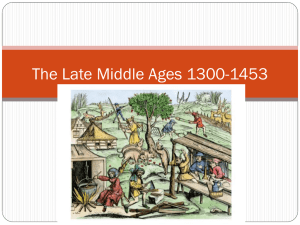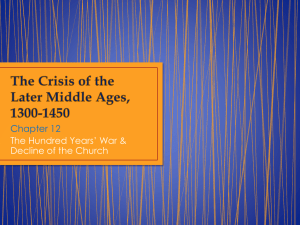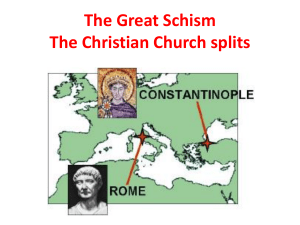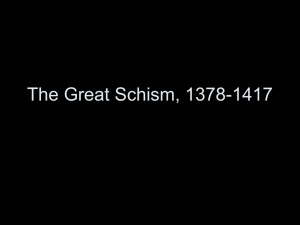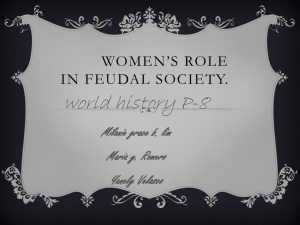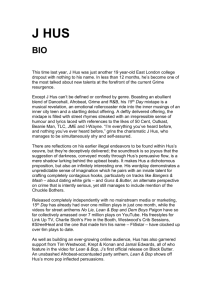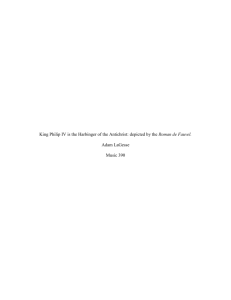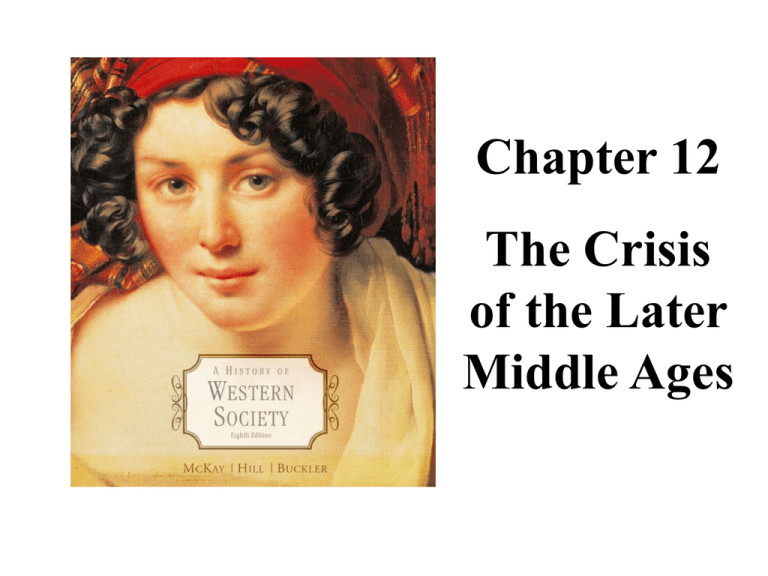
Cover Slide
Chapter 12
The Crisis
of the Later
Middle Ages
After reading and studying this
chapter:
• Explain the process that brought the Black
Death to Europe and how this disease spread
throughout Europe in the later middle Ages.
• Discuss the role of Dante, Chaucer, and Villon
in the transition from Latin to vernacular
languages and literature.
• Finally: you should be able to list factors in the
demise of the later medieval Catholic Church.
Prelude to Disaster
• The 1300s began with:
–
–
–
–
Inflation / price increases
Unusual Cold Weather / mini Ice Age
Bad weather / storms / floods
Crop failures / bad harvests / herd reduction
• All led to the Great Famine of 1315-1322
– Disease / de-population / fear
The waning of the Middle Ages
witnessed disease, war, and death.
• The Black Death wrought havoc in Europe in the
fourteenth century.
• Poor harvest led to famines in the years 1315—1317
and 1321.
• Diseases killed many people and animals.
• Genoese ships brought the bubonic plague to Europe
in 1347.
• The bubonic form of the disease was transmitted by
rats; people transmitted the pneumonic form.
• The disease continued to cause destruction as late as
1700.
Plague Cycle
The Black Death had many
consequences
• The plague was most disastrous among the
poor.
• The disease caused widespread suffering and
devastation.
• Priests, nuns, and monks were especially
vulnerable since they ministered to the sick.
• The danse macabe and other gloomy
artistic motifs reflected the pessimism
of the times.
Anatomical Man
The Limbourg brothers were commissioned
to produce Les Tres Riches Heures du Duc de
Berry, illustrations for each month of the year.
Immediately following the calendar is this
full-page rendering of Anatomical Man.
Scholars assume that the Limbourgs'
inclusion of it reflects Charles V's passionate
interest in astrology. The miniature purports
to illustrate the effect of the stars of the
zodiac on the human body. The inscriptions in
the corners indicate that human temperaments
are affected by the mixture of the traditional
four humors, as well as by the conditions of
heat and moisture, particularly as they are
associated with being either male or female.
The front figure represents the feminine, and
the figure in the back symbolizes the
masculine. An ellipse bearing the signs of the
zodiac surrounds the figures. (R.M.N./Art
Resource, NY)
The Hundred Years’ War (1337—
1453) added to the gloom.
• This struggle between England and France
added to misery of the age.
• England’s multifaceted army of warriors and
yeoman archers carried the day in the first
phase of the war.
– Crecy highlighted the new weapons of the English,
the longbow and the cannon.
– Poitiers (1356) was also an English victory.
– Agincourt (1415) was the last major English victory
of the war.
The Hundred Years’ War
Causes
• 1259 Treaty of Paris
– English King (Duke of Aquitaine) agreed to be a
vassal of France
– France agreed but did not follow through and
wanted Aquitaine so violated the treaty and seized
the province
• King Edward (English) also proposed that he
was the rightful heir of the French Throne as
the closest living heir of King Phillip of France.
– France has a civil war along with the English war to
avoid the strengthening of the French king.
– Some French barons supported the English etc…
Crecy, 1346
Pitched battles
were unusual in the
Hundred Years'
War. At the Battle
of Crecy, the
English (on the
right with lions on
their royal
standard) scored a
spectacular victory.
The longbow
proved a more
effective weapon
over the French
crossbow, but
characteristically
the artist
concentrated on the
aristocratic
knights.
(Bibliotheque
nationale de
France)
Copyright ©Houghton Mifflin Company. All rights reserved.
Map: England and France in the Hundred Years' War
England and France in the Hundred Years' War
The succession of maps depicts both why hit-and-run tactics worked for the English early in the war and why the English
were ultimately unable to defeat the French and take control of all of France. (Copyright (c) Houghton Mifflin. All rights
reserved.)
Copyright ©Houghton Mifflin Company. All rights reserved.
The War
• Popular
– Patriotic in that brought n awareness of
people of Nationalism
– Clergy preached / supported both sides
– Provided an opportunity for poor nobles to
become rich and serve / increased
opportunities for peasants as well. (wealth
and advancement)
The War
• Medieval warfare changed with technology
(The long bow)
• French lost militarily but won the war in the
end
– Peasant girl Joan of Arc saved the monarchy
– Orleans turned the tide for France
– Eventually the English withdrew
• Social consequences in both countries were long
term
– Beginnings of Parliament power (money needs) /
individual rights
– Nationalism in both countries
Joan of Arc played a significant role
in the ultimate French victory.
• She provided
inspiration and pride
for the French.
• A symbol of France
• Because of Joan, the
French persisted and
drove the English out
of France.
English view of Irish
Depicting a subject or colonial people as barbaric and uncivilized has long been a
way of denigrating and dehumanizing the enemy. In this thirteenth-century
miniature showing the English view of the Irish, a king (in a bath) and his
courtiers devour horseflesh with their hands, without plates or eating utensils.
The loss of the church’s prestige
was symptomatic of the age.
• The church came under fire because of
substantial corruption.
• Reformers argued for major changes.
– John Wyclif attacked papal authority and
called for reform of the church.
– John Hus spread Wyclif’s ideas to Bohemia.
Execution of Jan Hus
Jan Hus, born in Husinec in southern Bohemia (ca. 1369), was tragically burnt at the stake in 1415.
During his twelve years as a university lecturer, Hus denounced superstition, the sale of indulgences,
and other abuses. The people of Prague seemed to find his denunciations of an over-endowed church
appealing. He went into exile where he continued to dispute papal authority. In 1413 the emperor
Sigismund urged the calling of a general council to end the schism. Hus was invited and granted safe
conduct. Instead he was arrested, his teachings banned, and his books burned. In 1990, the date of his
execution was declared a Czech national holiday. (University Library, Prague)
The loss of the church’s prestige was
symptomatic of the age.
• The Babylonian Captivity (1309—1377)
was a major source of irritation.
– The church became a tool of the French
monarchy.
– The pope had lived at Avignon since the
reign of King Philip the Fair of France.
– The Babylonian Captivity badly damaged
papal prestige.
– Pope Gregory IX moved the papacy back to
Rome in 1377.
The Great Schism (1378—1417)
• Two popes claimed to be legitimate.
• Nationalism politics evolved
– England and France recognized different
popes.
– The Great Schism weakened the religious
faith of many of the faithful.
– Brought into doubt the motives of the church
leadership
– Brought about questioning of Church
Government.
The conciliar movement advocated
reform by a church council.
• Church councils with power superior to
that of the pope were introduced.
• Marsiglio of Padua had argued that
authority within the church resided with
a council not the pope.
– Similar to the struggle of the Monarchy at
the time
• The council of Constance (1414—1418)
ended the schism.
The Great Schism Ends
•
•
•
•
Both Popes deposed
A third Pope chosen but not supported
Finally Pope Martin V supported
Reformers like Hus dealt with
– No reform of the church
– New Pope dissolved the Council
– Triumphed over the Conciliar Movement
• Result delayed the reformation a century
The life of the people
• Marriage usually came at age 16 or 18 for
women and later for men.
– Legalized prostitution existed in urban
areas.
– Economic factors usually prompted
marriage.
– Divorce did not exist in this society.
Prostitute inviting traveling merchant
Poverty and male violence drove women into prostitution, which, though denounced by moralists, was
accepted as a normal part of the medieval social fabric. In the cities and larger towns where prostitution
flourished, public officials passed laws requiring prostitutes to wear a special mark on their clothing and
regulated hours of business. They forbade women to drag men into their houses (as we see the prostitute
doing in this illustration, as she invites a traveling merchant into her house), and denied business to women
with the "burning sickness," gonorrhea. (Bodleian Library, Oxford)
The life of the people
• The parish was the center of daily life.
– Sports such as bull-baiting and bear-baiting,
and drunkenness reflected the teeming
violence of the age.
• Fur-collar crime was prolific.
– Nobles returning from war resorted to
crime.
– Extortion and kidnapping by the upper
classes were widespread.
– Outlaws were sought for protection when the
governments failed. (Robin Hood)
Roman de Fauvel
illustration
Written by members of the
French court, Roman de
Fauvel is an allegory
containing 150 musical
compositions ranging from
monophonic Gregorian
chants to secular motets. The
main character is Fauvel, a
donkey, whose name is an
acronym for six vices-Flattery, Avarice,
Untruthfulness, Variability,
Envy, and Laziness.
(Bibliotheque nationale de
France/The Bridgeman Art
Library International)
Schoolmaster and wife teaching
Ambrosius Holbein, elder brother of the more famous Hans Holbein, produced this signboard for the Swiss educator
Myconius. It is an excellent example of what we would call commercial art--art used to advertise, in this case Myconius's
profession. The German script above promised that all who enrolled would learn to read and write. By modern standards the
classroom seems bleak: the windows have glass panes but they don't admit much light, and the schoolmaster is prepared to
use the stick if the boy makes a mistake. (Offentliche Kunstsammlung Basel)
Peasant unrest escalated in this
period.
• The Peasant Revolt of 1381 (England) resulted
from the lord’s attempt to freeze wages.
– Actually, peasants were better off in this period.
– Many revolts were due to rising expectations.
• The Jacquerie (France) (anti-noble) revolted in
France in 1358, 1363, 1380, and 1420.
– Most were ruthlessly put down.
• Similar incidents in Spain and Italy attest to
the unrest of the period.
– In Italy, the ciompi (workers) revolted.
John Ball
This miniature depicts John Ball, a priest of Kent, preaching his radical egalitarianism outof-doors after Mass. All contemporary writers blamed Ball for fomenting the rebellion of
1381. But the evidence of peasant demands shows that they were limited and local: hunting
rights in the woods, freedom from miscellaneous payments, and exemption from special
work on the lord's bridges or parks. (Private Collection)
Map: Fourteenth-century Peasant Revolts
Fourteenth-century Peasant Revolts
In the later Middle Ages and early modern times, peasant and urban uprisings were endemic, as common as factory strikes in
the industrial world. The threat of insurrection served to check unlimited exploitation. (Copyright (c) Houghton Mifflin. All
rights reserved.)
Copyright ©Houghton Mifflin Company. All rights reserved.
Statue of Ferdinand
All governments try to
cultivate a popular image.
For Ferdinand and
Isabella, it was the
appearance of piety.
Contemporaries, such as
the Burgundian sculptor
Felipe Bigarny, portrayed
them as paragons of
Christian piety, as shown
in this carved and painted
wooden effigy of
Ferdinand kneeling in the
royal chapter of Granada
Cathedral, where he was
buried in 1516. (Laurie
Platt Winfrey, Inc.)
Tres Rich Heures: February
The late Gothic style of manuscript
illumination was defined by the Limbourg
brothers--Jean, Paul, and Herman--who
flourished as artists during the late
fourteenth century and the early fifteenth
century. They were commissioned by the
Duke of Berry to complete two books of
hours, a personal book of devotions for
laypeople for the calendar year. The last
commission they undertook for the duke
was Les Tres Riches Heures du Duc de
Berry, begun in 1413. It is, perhaps, the
finest example of manuscript illumination
ever. The brothers were able to complete
illustrations for eleven of the months;
another artist completed November. At the
top of each calendar page is a two-tiered
arch. The outer arch consists of the zodiac
sign, the inner arch shows the blue dome of
heaven and Apollo, and below the arch is
the labor associated with each, as is evident
in this snowy February scene. (Victoria &
Albert Museum/The Bridgeman Art Library
Christine de Pisan
Christine de Pisan (1363?-1434?),
married at age 15 to a court secretary,
came into contact with educated men
who introduced her to Latin prose and
the works of Petrarch and Boccaccio.
At the age of 25, widowed and
grieving, she began to write poetry
and, later, turned her interest toward
the writers of antiquity. She is best
remembered for her two extended
works on the role of women in society:
The Book of the City of Ladies
(1405) and The Book of Three
Virtues (also known as The Treasury
of the City of Ladies). The latter
volume was dedicated to Marguerite of
Burgundy and established the criteria
for women who desired to live in the
city. In this manuscript illustration
Christine de Pisan writes her Collected
Works.
Transformation in literature
during this period.
• A. Dante Alighieri, in The Divine Comedy,
portrayed a symbolic pilgrimage through Hell,
Purgatory, and Paradise.
– His work embodies the psychological tensions of the
age.
– The work contains bitter criticism of
some church authorities.
• B. Geoffrey Chaucer’s The Canterbuy Tales
painted a gallery of English
people,
focusing on their
materialistic
interests.
Dante’s Inferno
In this frontispiece
from an early
manuscript of
Dante's Divine
Comedy, Dante,
wearing a red robe, is
guided by Virgil, in
blue, through the
agonies
of
hell.
(Bibliotheque
nationale de France)
Transformation in literature
during this period.
• C. Francois Villon’s Grand Testament
used the language of the lower classes.
– He portrayed reality, beauty, and hardship
of life on earth.
• D. Vernacular dialects began to find their
way into literature.
– The use of vernacular dialects reflected a
growing national consciousness.

